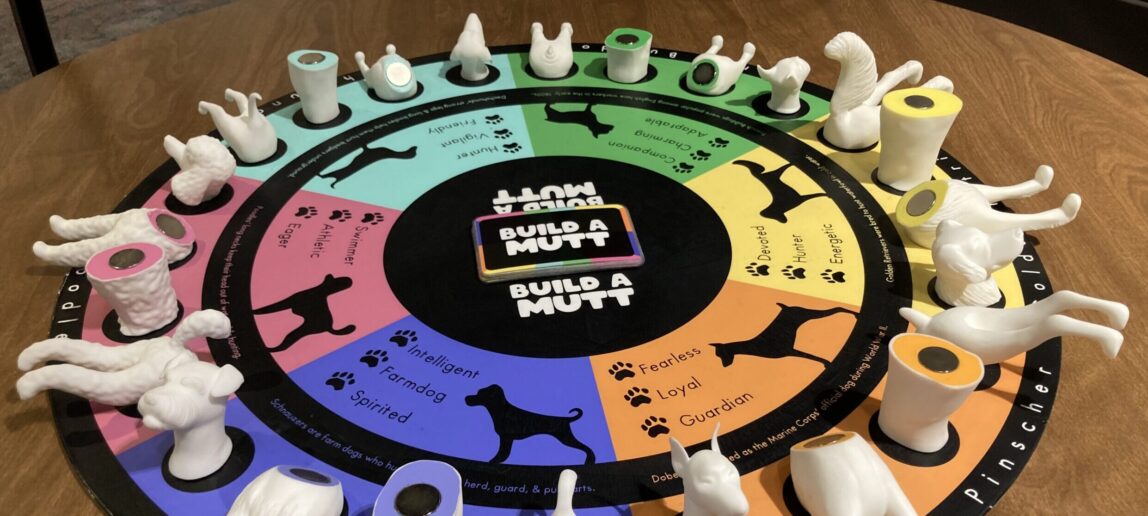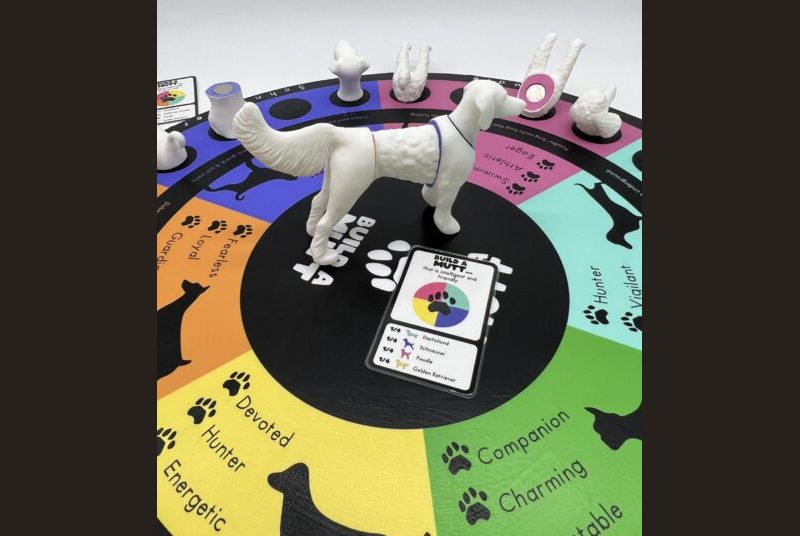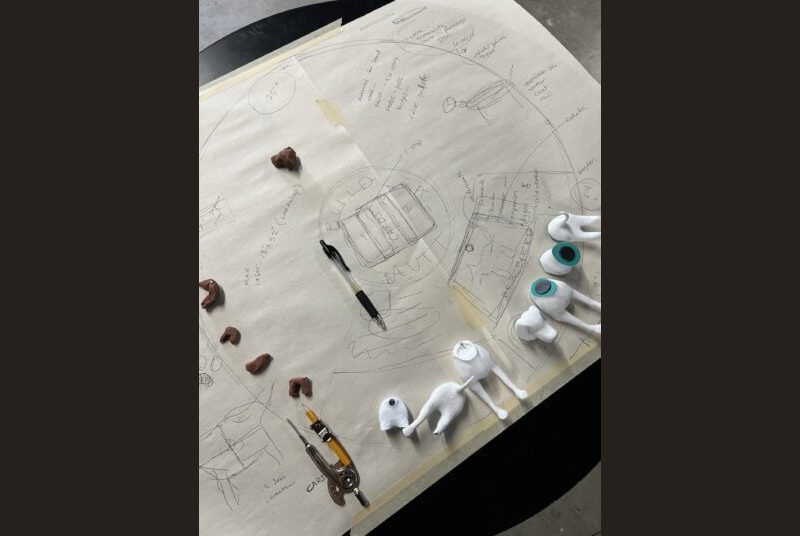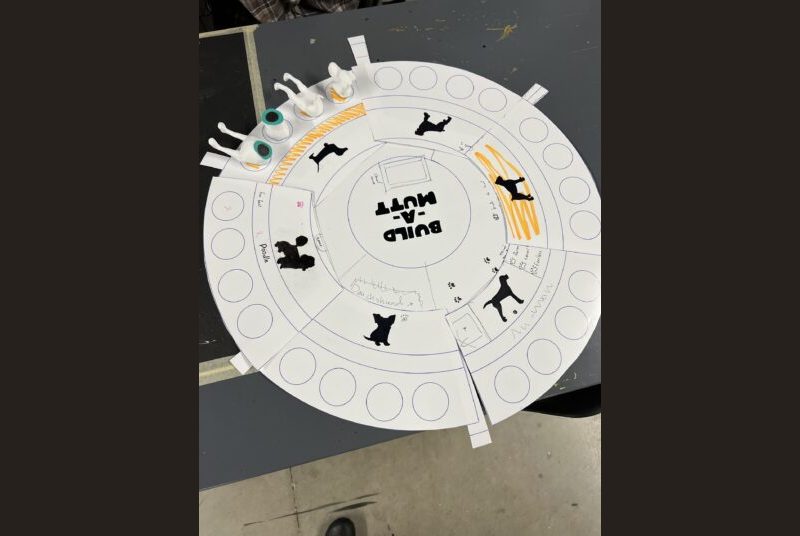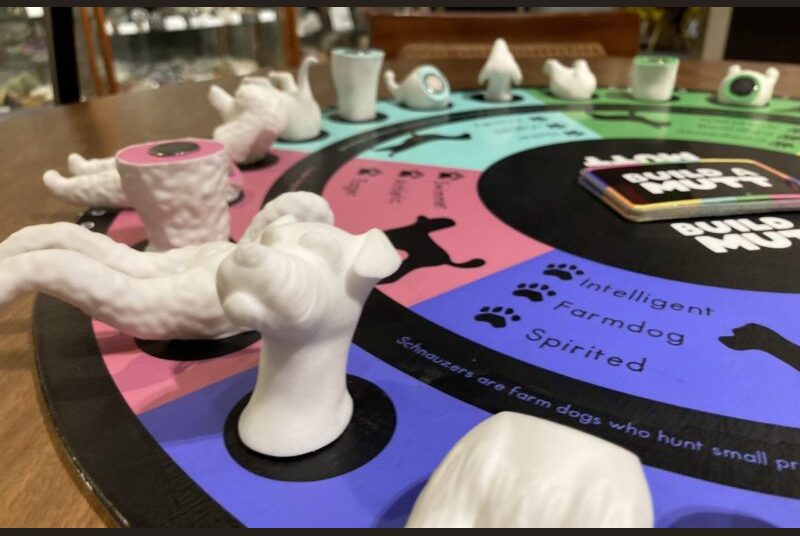Visualization Students’ ‘Build A Mutt’ Game Entertains At Museum Exhibit
When visitors stroll among the interesting items and artifacts at the Brazos Valley Museum of Natural History’s latest exhibit, they can sit and enjoy a classic pastime — the board game — thanks to graduate students in the College of Performance, Visualization and Fine Arts.
Visualization students created “Build a Mutt” for the “Dog Tales: The Human Canine Connection” exhibit. The colorful game allows players young and old to learn about dog breeds and traits, and to mix-and-match them through magnetic figures. The exhibit opened in November and continues through April 29.
Courtney Starrett, associate professor, had been working with Deborah Cowman, the museum’s executive director, on a potential collaboration in spring 2022. The approaching dog exhibit led to Starrett making a project part of the fall graduate course Form/Installation/Environment. Cowman met with Starrett and the 10 students early in the fall semester.
“Working with a natural history museum is very different than working with an art museum,” Starrett said. “The pieces must have an educational component and reach a very broad age group. Who should this be for? From toddlers to the elderly, which is a really tough design challenge.”
‘Gamify the idea’
The museum’s previous exhibit — “Checkered Past: The Story of Board Games” — provided some inspiration. A table with “Candy Land” was set up for visitors, and Cowman said she was shocked by the number of people who sat down to enjoy the familiar childhood game. That led Cowman to aim for such interactive elements for future exhibits.
Katelyn Noble, a third-year Master of Fine Arts student, said the topic of dog breeding gave her the idea of a puzzle in which people could piece together different breeds “as a sort of metaphor for human intervention of breeding.” That would eventually turn into the board game concept.
“Our group collectively began to evolve and gamify the idea so it became more educational,” Noble said. “We really wanted to show the positives of mixed breeds without making it too complex with the health issues associated with purebreds.”
Noble and Maleah Miller selected breeds based on their physical features, and then created them in the digital sculpting software Zbrush. Noble finalized the figures for 3D printing, including the four segment slices — head, front legs, torso, back legs and tail — where magnets would be attached. Farnoush Torkzadeh took the lead on the board design. Miller and Torkzadeh are also Master of Fine Arts students. Starrett sent the designs to a 3D print service bureau to build the figures in a nylon material.
“It’s a really robust, laser-sintering process where powder is fused with a laser,” she said. “So it’s very strong. It can be sanitized, so the figures wouldn’t be harmed if you use a Clorox wipe or run it through a dishwasher. That’s why we chose to make them that way.”
Given the age range of potential users, Starrett paid special attention to the posterior portions, adding rubber tails on some to avoid pointy ends that could be harmful to children.
“That’s her attention to detail, which is so wonderful about her,” Cowman said.
Instruction cards give prompts to start the mutt-making. Example: “Build a mutt that has a lot of energy and loves to play.” Then the percentages are shown: one-fourth golden retriever, one-fourth schnauzer, one-fourth French bulldog and one-fourth poodle. Players can then create their own version of this mutt by attaching the dogs’ body segments via the magnets.
Starrett said completing the game went down to the wire, but it was ready for the exhibit’s debut. The students attended the opening reception and watched as people enjoyed the game.
“It was so entertaining to see which parts someone chose or what traits they really wanted,” Noble said. “And it was hilarious to see the people who would just sort of create a train of dog torsos or something like that. I’m so proud to have worked on something that so many seem to enjoy engaging with. It’s just incredibly satisfying to know that a labor of love is loved by others.”
Popular attraction
Other visualization elements are featured in the exhibit, including a macro-photography collage of fur from wild canids by Emily Bujnoch, who earned a Master of Fine Arts degree in visualization in 2022 and is now an instructional assistant professor at the school. A video by Amy Richards, a 2016 Master of Fine Arts graduate, shows how dogs who had been separated from their owners react — in slow motion — to seeing them return.
“Build a Mutt” has been a popular attraction, and Cowman said she’s seen families sit for an hour playing it. She is hoping to collaborate with Starrett’s class again in the future.
“I love working with students,” she said. “They bring this fresh, energetic vitality and eagerness and enthusiasm that is so great.”
Starrett said there were lessons learned in developing a project like this in one semester, but she was pleased with how it turned out.
“We wanted to draw people in, engage them and create a memorable experience at the museum,” Starrett said. “If anything, maybe they leave that show saying, ‘Wasn’t that fun?’ or ‘I did something silly, and I’ll remember it.’ So it did that. It met our objectives as a design team: leaving people giggling and also engaged.”
